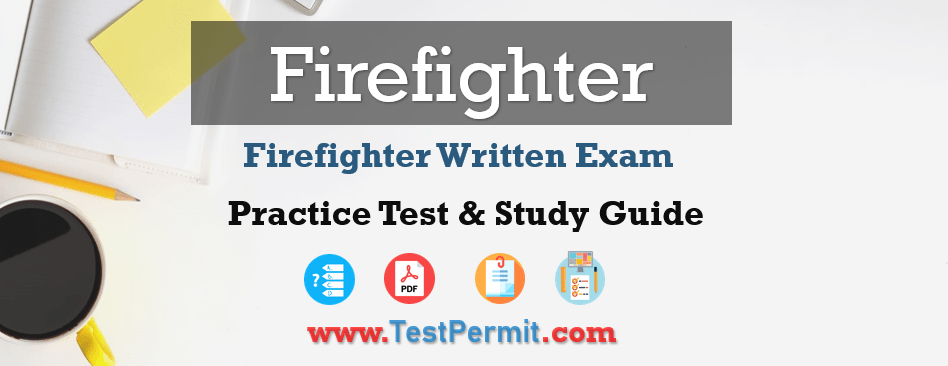Firefighter Exam Practice Test 2024 with Study Guide. Check our latest questions answers for all Firefighter Exam in USA. Download our free printable Firefighter Exam test pdf.
Firefighting is more than a job or career; it is a calling. Perhaps you remember the first time that you saw a fire truck pass by, rushing to some emergency, or watched as firefighters worked to save a life in peril. That day, you began to dream of a career as a firefighter.
Firefighter Exam
For you to earn the rank of firefighter, you must first prepare for the highly competitive examinations that mark the beginning of an increasingly difficult selection process. Today, this selection process also includes physical ability tests, medical qualifications, and personal interviews before you can be placed on the list.
Prepare for the written exam. Your test score on the written exam really counts. It’s not just a matter of passing the exam. Your goal is to wind up with a score that gives you an advantage over the competition. So give yourself plenty of time to get ready—in other words, start studying and taking the practice exams in this book as far in advance of the exam as you can.
Most exams are multiple-choice tests of the sort you have often encountered in school. You get an exam book and an answer sheet where you have to fill in little circles (bubbles) or squares with a number 2 pencil.
| Name of the Exam | Firefighter Exam |
| Country | USA |
| Exam Type | Ability Test (Written Exam) |
| Time Duration | 1.30 hours |
| Score or rank status | depending on the passing score |
| Question Type | Multiple Choice Questions |
| Answer Sheet | OMR Sheet |
Firefighter Exam Practice Test
Our free questions answers will guide you through each stage of the selection process and will help you strengthen your test-taking skills to improve your chances of success. The following Firefighter Exam Practice Tests are filled with useful information, advice, and practice exercises that will help you understand both how the hiring process works and how you can best meet the requirements.
Firefighter Exam Requirements
Most fire departments, or the city personnel departments that handle the selection process for them, establish a list of eligible candidates; many such lists rank candidates from highest to lowest.
The basic qualifications you need to even think about becoming a firefighter vary from city to city. It’s worthwhile to find out what those qualifications are in the agency you want to serve. Some qualifications are pretty standard:
- A minimum age—sometimes this can be as low as 18, but 21 is the age that seems to be most common today. In some departments, there is a maximum age, but for the most part, these have been replaced by the requirements of physical ability tests and health.
- A high school diploma, or its equivalent, but now many departments require some college, and a few are looking for an associate’s degree or perhaps a professional certification.
- A clean criminal record
- Excellent physical and mental health
- A valid driver’s license and a satisfactory driving record
Required Medical Qualifications, Education, and Licenses for Appointment: Upon appointment, the candidate must:
- Possess a valid driver’s license.
- Be a high school graduate or hold an equivalent certificate.
The Candidate Physical Ability Test (CPAT)
The Candidate Physical Ability Test is the next step in the process for many fire departments; some put this step first. You should expect to have a medical clearance, or at the very least sign a medical waiver stating that you are in good enough shape to undertake this stressful test, before you will be allowed to participate. The fire department wants to make sure that no one has a heart attack in the middle of the test. So, you can expect the test to be tough.
Here is an example of the events in a test that you would typically have ten minutes, 20 seconds to complete:
- Stair climb with weighted vest
- Hose drag
- Equipment carry
- Ladder raise and extension
- Forcible entry
- Search
- Rescue dummy drag
- Ceiling breach and pull
Job or career
There were approximately 361,000 individuals employed in the fire service in the United States in 2006. About 293,000 were line firefighters, whereas the rest were supervisors or other support staff. The majority of these individuals, about nine out of ten according to the Bureau of Labor Statistics (BLS), are employed by municipal or county fire departments serving communities of 25,000 people or more. Large cities are the largest employers, but many intermediatesized municipalities also employ career firefighters.
In the private sector, many large industrial companies have their own firefighting forces, especially companies in the oil, chemical, aircraft, and aerospace industries. Other employers include airports, shipyards, and military bases. A growing number of companies are in the business of providing fire protection services—including on-call or on-site firefighting teams—to other businesses and institutions.
